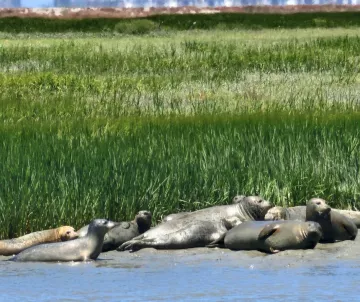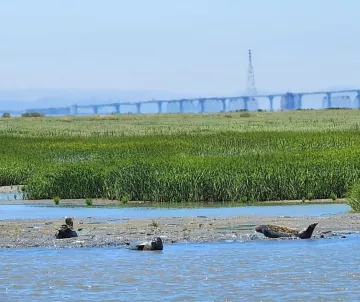
The Don Edwards National Wildlife Refuge consists of about 30,000 acres of crucial wetland habitat, with about 3,080 acres belonging to the Alviso portion. The Refuge is a vital sanctuary for migrating birds travelling along the Pacific Flyway as well as many endangered species, such as the salt marsh harvest mouse, the Ridgway’s Rail, and the Western Snowy Plover. The DENWR is a part of the South Bay Salt Pond Restoration Project which is the largest tidal wetland restoration project on the West Coast, with a goal of transforming about 15,000 acres of industrial land into wetland ecosystems.
In the 1850s, a large portion of the Bay was filled, diked, or drained for commercial purposes, however, the South Bay was primarily used for commercial salt production. Luckily, in 1972, Congress designated a portion of about 22,000 acres of that commercial salt pond land to become what is now known to be Don Edwards National Wildlife Refuge. Currently, the refuge faces the building of a new high speed rail track.
Threats
Currently, the Don Edwards National Wildlife Refuge is threatened by the possibility of a new high speed rail track intruding on parts of the Refuge. The proposed bridge that would run through the sanctuary would disrupt the abundant wildlife and delicate ecosystems that make the Refuge so imperative to its surrounding communities. Along with offering land for recreational activities, wetland environments provide critical ecosystem services such as carbon sequestration, flooding and storm surge protection, water quality assurance, as well as vital habitat for many species. Sierra Club Loma Prieta Chapter member and Citizens Committee to Complete the Refuge board member, Eileen McLaughlin, has been a long term advocate for the protection and expansion of the Don Edwards National Wildlife Refuge. The chapter has supported Eileen’s efforts in the protection of this essential Wildlife Refuge and will continue to do so as discussion continues about the construction of the high speed rail. Support the Loma Prieta Chapter activism educating the public and elected officials about the importance of protecting Don Edwards National Wildlife Refuge. Become a member, donate to our conservation programs, and help one of our conservation teams.
Value as Wildlife Corridor

The Don Edwards National Wildlife Refuge provides many benefits for wildlife from around the world. The Refuge is a stop for migratory birds along the Pacific flyway, which extends from Patagonia to Alaska. The Refuge monitors endangered and threatened species such as the Ridgway’s Rail, the salt marsh harvest mouse, the vernal pool tadpole shrimp, the Contra Costa goldfields, the Western Snowy Plover, and the California Tiger Salamander. These monitoring programs are important to maintain well balanced ecosystems as they ensure the populations of these delicate species aren’t declining.
The Refuge is also host to wildlife such as harbor seals, the California gray fox, gopher snakes, fairy shrimp, sturgeon, and voles, just to name a few. The Refuge consists of 15 different habitats, with the five major categories being marsh, ponds, mudflat, vernal pools, and uplands. Such a variety of habitats welcomes many different types of wildlife to reap the benefits of the Don Edwards National Wildlife Refuge.
Value as Flood Control
One of the most socially, economically, and environmentally beneficial aspects of the Don Edwards National Wildlife Refuge is its service of flood control. The abundance of wetland habitat in the Refuge acts as a sponge for any incoming flows of water from the Bay. The wetlands slowly release an excess water, controlling the effects of heavy storm flows. Wetlands can also balance the increased surface-water runoff resulting from large urban areas. This is incredibly important for surrounding communities, particularly as sea level rise begins to threaten the Bay Area.
Value as Carbon Sequestration
Wetlands are valuable as carbon sinks due to their ability to intake carbon and store it in the soil. Wetland plant species can hold a significant portion of carbon despite not occupying large masses of land. One study by Nature Communications suggests that wetlands hold about 20-30% of the earth’s soil carbon while only occupying about 5-8% of the land surface. This is crucial as wetlands can help manage the large amounts of carbon, a greenhouse gas, in our atmosphere brought about by human induced climate change, in turn purifying the Bay air.
Value as Water Quality Assurance
Wetlands serve as a natural filter for water. Wetlands take in pollutants such as phosphorous, heavy metals, and toxins which come from the sediments. The wetlands of the Don Edwards National Wildlife Refuge allow pollutants to be captured and stored before they have the chance to run off into the open waters of the Bay. Without this vital filtering service wetlands provide, the Bay Area would need to pay large sums of money for alternative filtering systems to maintain water quality.
Links
- Don Edwards National Wildlife Refuge Youtube video
- U.S. Fish & Wildlife Service -- Don Edwards San Francisco Bay Wildlife Refuge
- EPA: Why Are Wetlands Important
